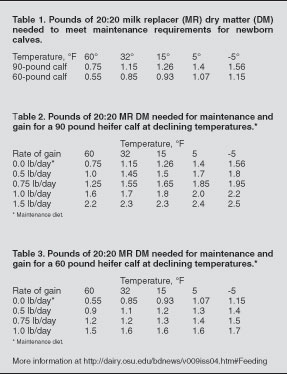No time like the present to talk about feeding calves in cold weather.
While the feeder puts on more clothes to help them stay warm, the “layers” of clothing our calves can put on to help them stay warm is nutritional.
Yes, a calf coat or blanket of some sort can help a calf maintain some body heat, but she will absolutely need more nutrients if we want to maintain calf growth and health.
Background
First, a calf is born with approximately 3 percent body fat. Barely enough of that fat is available to the calf to meet her energy requirements for the first 18 hours of life. Colostrum has twice the level of fat than normal milk to start addressing the calf’s need for energy at birth.
Second, there is a finite range of temperatures where an animal does not require additional energy to simply maintain the body (maintenance).
In other words, the body functions properly, but neither gains nor looses weight.
Calves most sensitive
Calves are the most sensitive to external temperatures of any bovine age group. Newborn calves have a lower critical temperature around 55 degrees. So, when the temperature in their environment drops below 60 degrees, calves require additional nutrients to maintain their body weight.
After a week, they can handle a few more degrees of cold.
Maintenance requirements
How do we need to adjust nutrition for calves in cold weather? Using an 90-pound calf (Holstein) and a 60-pound calf (Jersey) as examples, in Table 1 we can see that a critical need for additional nutrition occurs as temperatures drop toward freezing.
Traditional industry milk replacer feeding recommendations are to feed large breed calves 1 pound of milk replacer powder split between two feedings per day (hence the 8-ounce “cup”).
When the weather is warm, feeding 1 lb./day not only meets the 90-pound calf’s maintenance needs, but will also allow her to gain up to half a pound per day for a short period of time.
To maintain health, calves should be growing. They need some reserves of body fat to draw on as they fight normal calfhood “bugs”.
When a calf spikes a fever of 2.5 to 3 degrees higher than normal, her maintenance energy requirements can increase by 25 percent to 30 percent. She will crash like a rock if she has no body reserves to draw on.
Tables 2 and 3 show milk replacer needs for both maintenance and several rates of gain at declining temperatures.
Occasionally you’ll see the same amount of milk replacer supporting the same amount of growth at more than one temperature. In the case of the 60-pound calf, if we desire a 1 pound per day rate of gain, the 1.6 pounds of 20:20 milk replacer DM requirement provides enough protein for that level of gain.
However, excess energy is available to meet increasing maintenance requirements until the temperature drops to 5 degrees where that diet is balanced.
In other diets, energy is the limiting nutrient, and excess protein fed will be excreted by the calf.
Practically…
I am not suggesting that you change how much you feed every time the temperature fluctuates. What a pain in the neck! Choose a level that will allow the calves to gain at least your targeted rate of gain.
For example, if you feed 1.6 pounds of a 20:20 milk replacer with the goal of gaining a pound per day when it is 60 degrees, your calves should gain at least half a pound a day until the temperature gets down to about 5 degrees.
Will it cost more to raise calves in the winter? Maybe, depends on how much you spend now to treat sick calves who can’t fight challenges, and how many calves might be dying.
The payoff is having calves that grow and have the body reserves to help them fight the bacterial, viral and temperature challenges that come their way.














Hey thanks this is going to help me a little on my Science Fair Project!